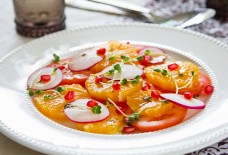Traditional Music in Morocco Series (Episode 5 of 7): Chaabi/Fusion
By: Claire Boyle / Arab America Contributing Writer
Introduction:
The country of Morocco is one of many cultures, beautiful architecture, amazing cities, and it also has its own unique musical and dance genres that are borne out of numerous traditions. These traditions stem from many influences including the cultures of the Amazigh, Arabs, Berbers, Gnawa, Islamic syncretism, Sufism, and Europeans, and so many more. Morocco has the world-famous traditions of Chaabi/Fusion, Gnawa music, Arab-Andalusian Classical, and so many other genres. This seven-part series will explore the cultural, geographic, and historical backgrounds of these amazing genres and readers will get to experience some samples of each musical style as well.
In this fifth installment, we will be traveling to northern Morocco in the Rif Mountains to explore the enthralling sounds of Chaabi/Fusion music that serve as a method to provide political and social critique through music.
Geographic Origins of Chaabi/Fusion:
So, where does Chaabi/Fusion music come from? Well, Chaabi actually comes from multiple places given that it blends both the music of the urban and rural areas of Morocco. Chaabi traces its lineage to the Rif Mountains in northern Morocco, and it is of Berber origin. Chaabi is also becoming more popular in urban areas, and the purpose of the music is to provide social commentary and protest on certain situations.
Historical and Cultural Origins of Chaabi/Fusion:
The genre of Chaabi is well-known throughout North Africa especially in the countries of Algeria, Morocco, and Egypt which all have their own brand of Chaabi. So, what element makes it ‘Fusion’ music? The cultural origins surrounding this type of music makes it akin to “American jazz music, in that no two performance are the same.” Thus, that would make it seem reasonable that Chaabi relies on improvisation, and that it combines other musical styles which is why it is also called ‘Fusion.’
The historical origins of Chaabi/Fusion also date to the “1930s, and it also draws inspiration from Andalusian classical music.” Andalusia refers to a region of Spain known in the Arab World as Al-Andalus when the North African Moors ruled Spain for over 700 years.
Another interesting cultural aspect of Chaabi is that it has “quite an element of religious spiritualism involved, specifically, the idea that the music and dance style is inhabited saints and the supernatural.”
So, then what do these origins symbolize both about the history and culture of Morocco and the Berbers? Well, the fact that many cultures, musical genres, and people are involved in creating this music, seems to mean that Chaabi embraces multiculturalism, gathering and sharing life together. The meaning of the word Chaabi even denotes this idea being that it translates to “folk.”
So, how is Chaabi/Fusion music performed and what musical instruments are used in the creation of this amazing artform? Chaabi is performed with “hand-clapping, poetry, [improvisation of the songs], dancing, shouting, an oud, singing, and hand drums.” Finally, Chaabi/Fusion is truly one traditional musical genre that embraces multiculturalism and celebrates intercultural dialogue through music. How is this evident? Well, Chaabi/Fusion music is inspired by “Arab, Andalusian, Berber, Sufi, Gnawa, Malhun, and Western music!” Talk about a beautiful explosion of sound!
Samples of Chaabi/Fusion: A Traditional Music and Dance Style of Morocco:
So, it is now time to experience the wondrous genre of Chaabi/Fusion! This is one musical genre to surely get your feet tapping and hands clapping as the rhythms are lively, stirring, and beautiful! Enjoy the samples below!
Conclusion:
Chaabi/Fusion is such a beautiful musical, dance, cultural, and religious style because it is lively, looks exciting and its rhythms are rousing. Chaabi/Fusion also has a lot of cultural and geographic history behind it because of its origins in the Rif Mountains of northern Morocco. The Chaabi/Fusion musical style has a wonderful tradition because it is meant to bring people together, promote unity, and explore the multifaceted aspects of culture through song. These traditional musical styles elicit feelings of passion, and the reason listeners get these senses is that these sounds and rhythms are the amazing cultural expressions of humanity worldwide. It is the author’s hope that everyone got the opportunity to learn a little bit more about the enthralling style of Ahwash, and perhaps, that you were able to tap your feet to the fun and rumbling sounds of traditional Moroccan music and dance!
This is the fifth episode in a series of seven about some of the traditional music and (oftentimes) dance styles in Morocco. This series explores the cultural, historical, and geographic backgrounds of the musical and dance styles themselves and the group of people who brought these traditions to the forefront in Morocco. Keep an eye out for the next article featuring the beautiful sounds of Arab Andalusian classical music!
Check out Arab America’s blog here!








